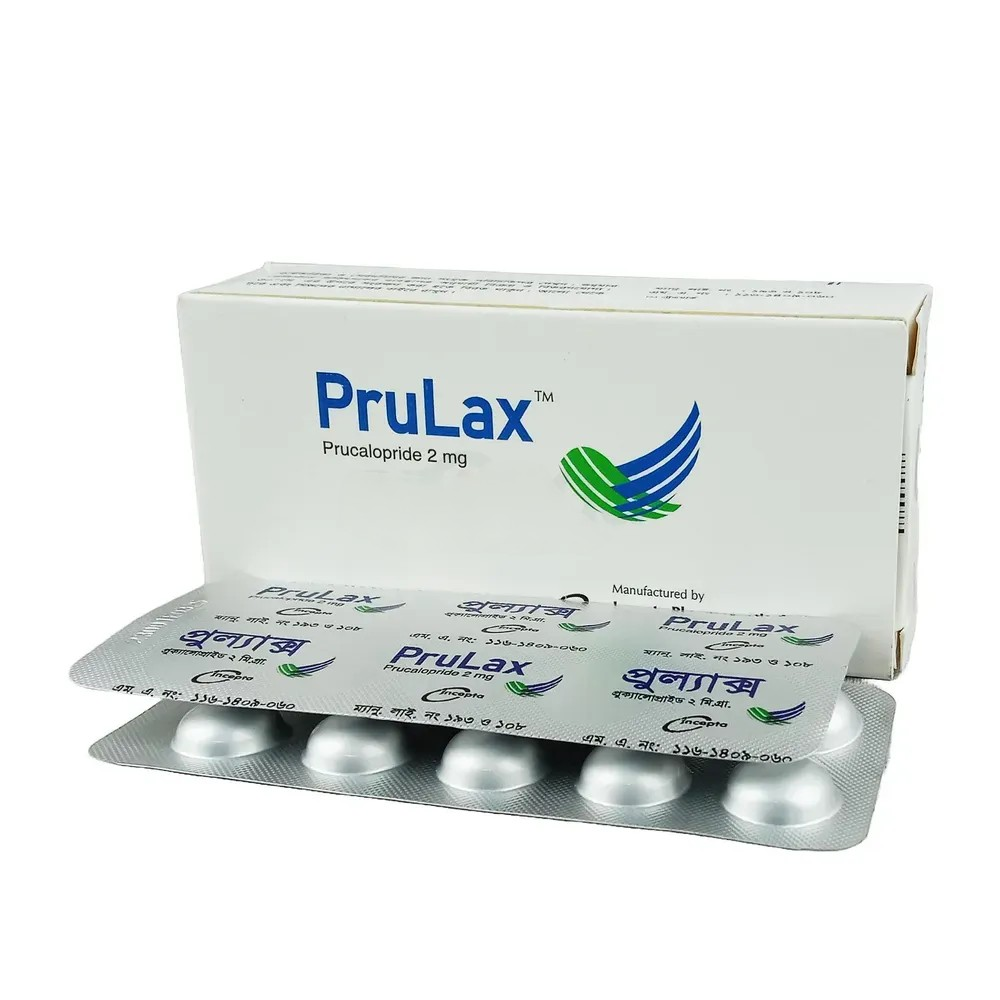Unit Price:
৳ 24.00
(3 x 10: ৳ 720.00)
Strip Price:
৳ 240.00
Also available as:
Indications
PruLax tablet is indicated for symptomatic treatment of chronic constipation in adults in whom laxatives fail to provide adequate relief.
Pharmacology
Prucalopride acts as a selective stimulator of the 5-HT4 receptors while having no interaction with hERG channel or 5-HT1 receptors which reduces significantly the cardiovascular risk found in other similar drugs. 5-HT4 receptors can be found throughout the gastrointestinal tract primarily in smooth muscle cells, enterochromaffin cells, and myenteric plexus. Its activation produces the release of acetylcholine which is the major excitatory neurotransmitter in the GI tract. Hence, prucalopride stimulates motility by interacting specifically with 5-HT4 receptors in the GI tract which causes a release of acetylcholine and further contraction of the muscle layer of the colon and relaxation of the circular muscle layer leading to the propulsion of luminal content.
Dosage & Administration
Adults: 2 mg once daily with or without food, at any time of the day. Due to the specific mode of action of prucalopride (stimulation of propulsive motility), exceeding the daily dose of 2 mg is not expected to increase efficacy.
Older people: Start with 1 mg once daily; if needed the dose can be increased to 2 mg once daily.
Children: Prucalopride should not be used in children and adolescents younger than 18 years
Older people: Start with 1 mg once daily; if needed the dose can be increased to 2 mg once daily.
Children: Prucalopride should not be used in children and adolescents younger than 18 years
Interaction
In-vitro data indicate that, PruLax has a low interaction potential and therapeutic concentrations of PruLax are not expected to affect the CYP-mediated metabolism of co medicated medicinal products. Although PruLax may be a weak substrate for P-glycoprotein (P-gp), it is not an inhibitor of P-gp at clinically relevant concentrations.
Ketoconazole (200 mg b.i.d.), a potent inhibitor of CYP3A4 and of P-gp, increased the systemic exposure to prucalopride by approximately 40%. This effect is too small to be clinically relevant. Interactions of similar magnitude may be expected with other potent inhibitors of P-gp such as verapamil, cyclosporine A and quinidine.
Studies in healthy subjects showed that, there were no clinically relevant effects of PruLax on the pharmacokinetics of warfarin, digoxin, alcohol, paroxetine or oral contraceptives.
Ketoconazole (200 mg b.i.d.), a potent inhibitor of CYP3A4 and of P-gp, increased the systemic exposure to prucalopride by approximately 40%. This effect is too small to be clinically relevant. Interactions of similar magnitude may be expected with other potent inhibitors of P-gp such as verapamil, cyclosporine A and quinidine.
Studies in healthy subjects showed that, there were no clinically relevant effects of PruLax on the pharmacokinetics of warfarin, digoxin, alcohol, paroxetine or oral contraceptives.
Contraindications
Prucalopride is contraindicated in those people who are hypersensitive to the active substance or to any of the excipients and people with renal impairment requiring dialysis.
Side Effects
The most frequently reported adverse reactions associated with PruLax therapy are headache (17.8%) and gastrointestinal symptoms (abdominal pain), nausea and diarrhoea. The adverse reactions occur predominantly at the start of therapy and usually disappear within a few days with continued treatment. Other adverse reactions have been reported occasionally. The majority of adverse events were mild to moderate in intensity.
Pregnancy & Lactation
Prucalopride is not recommended during pregnancy and women of childbearing potential should use effective contraception during treatment. Animal studies do not indicate direct or indirect harmful effects with respect to pregnancy, embryonal/fetal development, parturition, or postnatal development. In the absence of human data, it is not recommended to use Prucalopride during breastfeeding
Precautions & Warnings
- Renal excretion is the main route of elimination of prucalopride. A dose of 1 mg is recommended in subjects with severe renal impairment.
- Caution should be exercised when prescribing PruLax to patients with severe hepatic impairment (Child-Pugh class C) due to limited data in patients with severe hepatic impairment.
- In case of severe diarrhoea, the efficacy of oral contraceptives may be reduced and the use of an additional contraceptive method is recommended to prevent possible failure of oral contraception.
- The tablets contain lactose. Patients with rare hereditary problems of galactose intolerance, the Lapp lactase deficiency or glucose-galactose malabsorption should not take this medicinal product.
Use in Special Populations
Renal Impairment: The dose for patients with severe renal impairment (GFR <30 ml/min/1.73 m2) is 1 mg once daily. No dose adjustment is required for patients with mild to moderate renal impairment.
Hepatic Impairment: Patients with severe hepatic impairment (Child-Pugh class C) start with 1 mg once daily which may be increased to 2 mg if required to improve efficacy and if the 1 mg dose is well tolerated. No dose adjustment is required for patients with mild to moderate hepatic impairment.
Hepatic Impairment: Patients with severe hepatic impairment (Child-Pugh class C) start with 1 mg once daily which may be increased to 2 mg if required to improve efficacy and if the 1 mg dose is well tolerated. No dose adjustment is required for patients with mild to moderate hepatic impairment.
Overdose Effects
An overdose may result in symptoms resulting from an exaggeration of prucalopride's known pharmacodynamic effects and include headache, nausea and diarrhoea. Specific treatment is not available for PruLax overdose. Should an overdose occur, the patient should be treated symptomatically and supportive measures instituted, as required. Extensive fluid loss by diarrhoea or vomiting may require correction of electrolyte disturbances.
Therapeutic Class
Osmotic purgatives
Storage Conditions
Store at room temperature, below 30°C. Do not remove desiccant. Dispense in original bottle.


